OpenMusE Consortium
We are looking for end-users and dissemination partners to test our data and visualization products
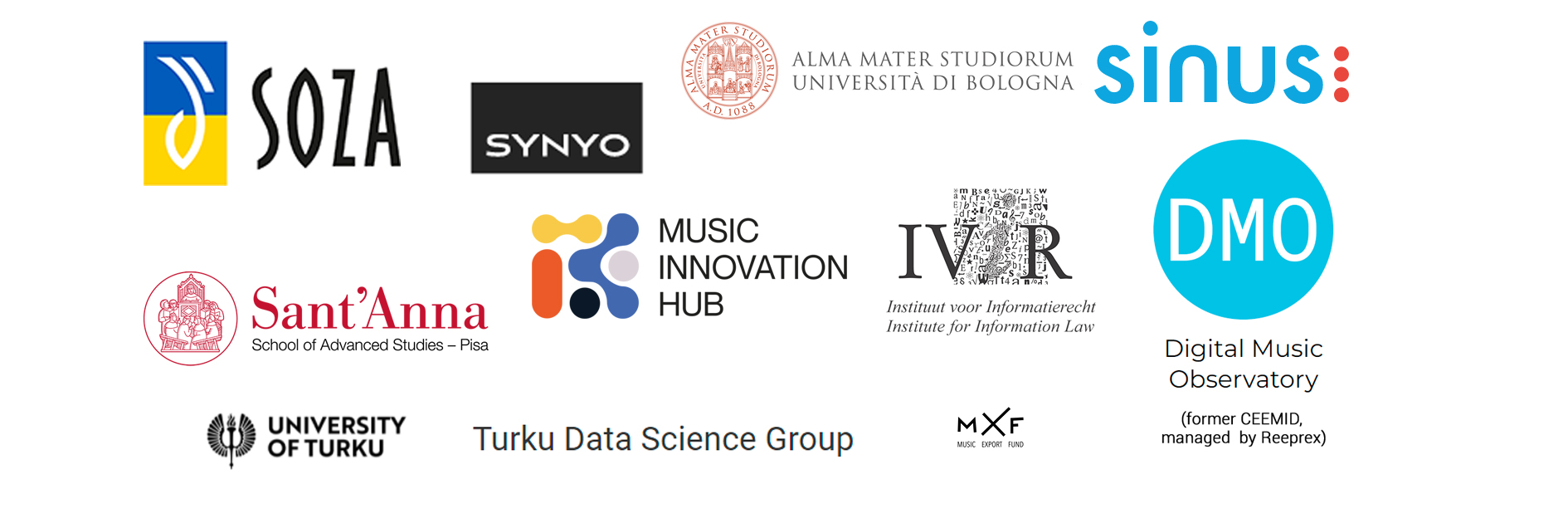
OpenMusE brings together music industry stakeholders and researchers from 12 European countries. Our partners represent the diversity of the industry, as well as the shared need to find financially, socially, and environmentally sustainable policy and business models in multiple, sometimes-fragmented streams (e.g., live music, composers/publishers, and recordings with producers and performers).
Good policies require supporting evidence, and good business planning and copyright exploitation require high-quality data. OpenMusE will provide such data through novel, open-source tools that leverage automation to enable transfer to nearly any European market. We will disseminate our data via “live policy documents” and visualisations hosted on our Open Music Observatory, which automatically update when data sources are refreshed. This will set a concrete precedent and a clear path towards a more competitive, fair, and sustainable European music ecosystem.
Open collaboration
Our project is based on open collaboration. Our proposal, if funded, will provide us with resources to supply further music businesses, music civil society organizations and researchers with high-quality data (during the duration of the project for free.) We are already looking for interested parties to put our data and research projects into use and validate their usability and quality in real-life policy or business development scenarios.
Data that we can offer
By providing continually updated data on five industry pillars – innovation, music and society, music economy, music diversity and circulation, and music policy – we will accurately capture the economic and social value created by the sector, as well as providing stakeholders with data-driven means of maximizing this value.
- For copyright and neighbouring rights-holders and their organizations: Value of music, euro value of the value gap, private copying, privacy—we have data and make estimates with all known music value estimation techniques.
- For live music organizations: Pan-European audience surveys; demographic comparisons of all European audiences; attendance predictions, attendance profiling.
- For granting authorities: we have the world’s largest survey-based dataset on how musicians work and live; we create ex ante needs assessment and grants evaluation indicators and ex-post grant evaluation indicators.
- For labels and music publishers: we make big data understandable; we create price and volume indexes of streaming markets; we tell you about price developments and selection probabilities in different cities and countries; we understand the biases of the Spotify and YouTube algorithms; and we measure (meta)data problems and offer scalable solutions.
- For music export offices: we measure domestic and foreign market shares in streaming; we create actionable key performance indicators; and we do geographical targeting.
The OpenMusE Consortium
Service Development, Project Management, Coordination and Dissemination
- Reprex is the originator of the OpenMusE project which builds on the achievements of the former CEEMID project, and provides leadership in WP Dissemination with building the Open Music Observatory, a full-fledged, open science-based statistical service that can complement the Eurostat Rest API and the future European Music Observatory on the basis of the Digital Music Observatory prototype validated in Yes!Delft AI+Blockchain Lab and the JUMP European Music Market Accelerator.
- Sinus-Institut, (DE) an innovative market- and policy research SME is the coordinator of the project, and provides leadership on WP Music, Society and Citizenship with promoting best, harmonized practices of the measurement of cultural access and participation.
- Synyo, (AT) an innovative research company is participating in the coordination and dissemination of the project.
Business partners
- SOZA (SK), the representative organization of Slovak composers and lyricists, and the global composer community within Slovakia, will develop an impact assessment with us on the promotion of the Slovak music in radios (with local content quotas) and streaming platforms, and assist partners in various diversity related actions. SOZA is a founding partner of the CEEMID project.
- HearDis! (DE), a German innovative music tech company is participating in building uses case of uses of music that harmoniously fit into the local music ecosystems and do not colonize lucrative uses of in-store and other public performance.
- Aloaded (SE), a 100% independent Stockholm-based digital distributor is participating in the development of new streaming market transparency indexes. We will create stock-exchange like streaming price, volume indexes to increase the transparency and business development of small labels and self-released artists.
- Artisjus (HU), the representative organization of Hungarian composers and lyricists, and the initiator of the CEEMID project, together with SOZA, will assist Musicautor to re-valuate the use of music in Bulgaria in a way that can be scaled to any European country, and try to improve probably the poorest markets revenues similarly to the good results of the former CEEMID in Hungary and Slovakia.
- Musicautor (BG), the representative sister organization of Bulgarian rightsholders, will validate the valuation methodologies of our projects with putting them in use, trying to replicate the double-digit growth from Hungary and Slovakia.
Civil Society & Social Enterprise partners
- ICMP (Global, EU), the “global voice for music publishing,”, will be our partner to fill the data gaps identified by Feasibility Study on the Establishment of the European Music Observatory related to the publishing revenue stream of the European music business.
- Music Innovation Hub (IT), an Italian social enterprise, is validating our sustainability reporting tool.
- Music Exchange Fund (LT), a Lithuanian NGO that helps the promotion of Lithuanian artists abroad, will utilize the trustworthy AI and data management system originally developed by SOZA and Reprex to build a similar system in Lithuania and Ukraine.
- Music Export Ukraine (UA), a Ukrainian NGO promoting the music export of Ukraine, will further develop the Ukraine Music Industry Databases and build a similar application to the Music Exchange Fund.
Academic partners
- Turku Data Science Group (FI)at the University of Turku will lead the WP Innovation and build an ecosystem of open source applications within the rOpenGov open collaboration platform with Reprex that enable the music industry to create a self-service, Open Music Observatory that will produce statistical products in a similar quality, form, and service level like the Eurostat Rest API.
- Institute for Information Law (IViR) of the University of Amsterdam, will lead the WP Economy of Consortium, including scaleable, standardized valuations that can be placed in use anywhere in Europe, conduct research in the market value of metadata, and provide leadership in economic methodologies.
- Sant’Anna School of Advanced Studies (IT) of the University of Pisa will lead the WP Diversity and provide leadership in creating methodologies, indicators and open policy recommendations that can support the circulation of European music and the measurement and promotion of local and national repertoires in broadcasting, streaming and retransmission.
- University of Economics in Bratislava (SK) will develop indicators and validate our results in a national policy setting.
What Do We Offer To Scientific Partners?
We provide exclusive scientific access to highly valuable quantitative datasets in music, particularly nationally representative audience surveys, nationally representative music creator surveys, and large music streaming data. We provide know-how and data science infrastructure that facilitates data collection via surveys or big data by utilizing pre-existing open science or open government sources.
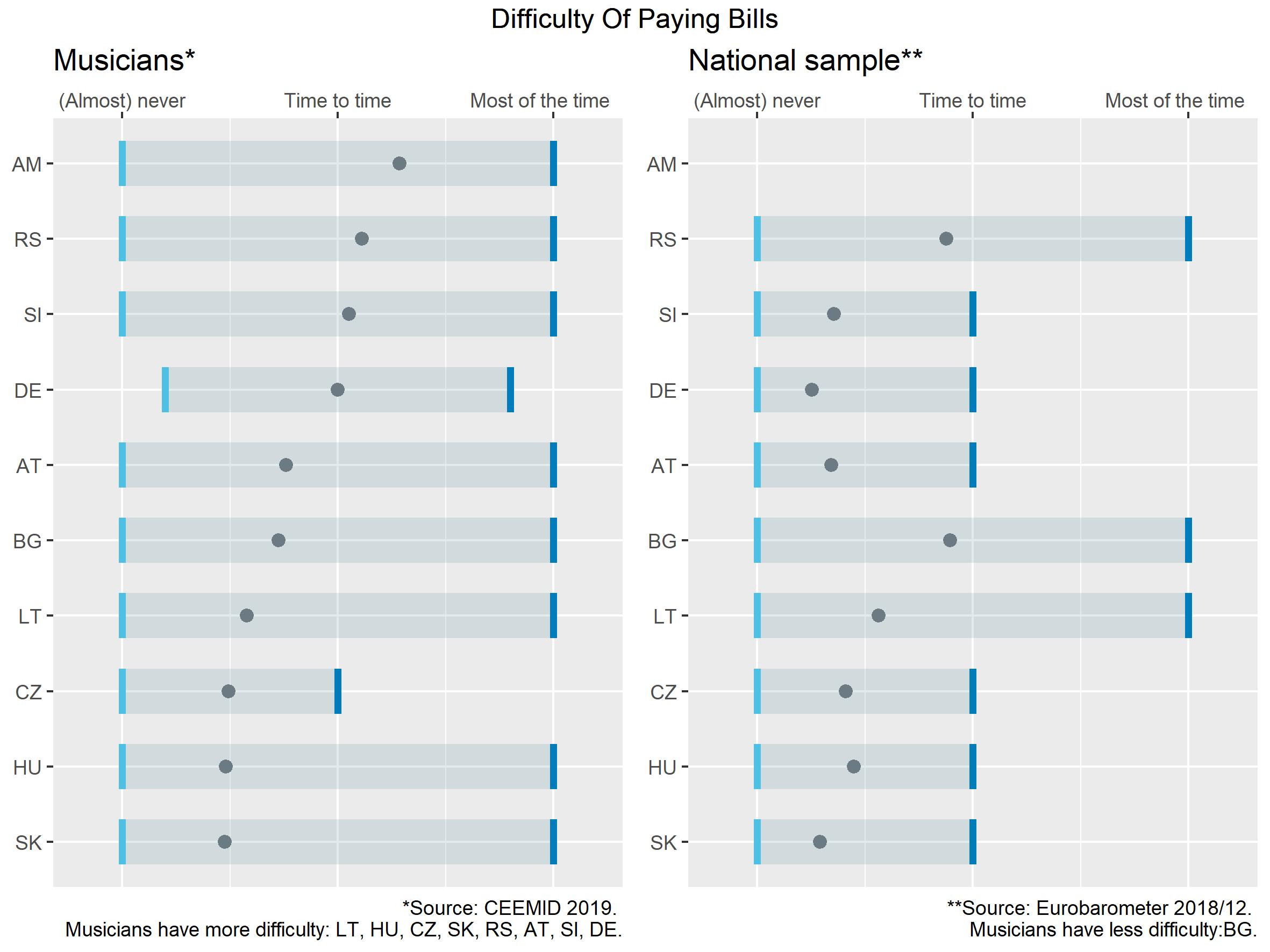
We will provide researchers with data according to their needs, and make sure that their quantitative research will have the best scientific and policy impact. Our goal is to ensure our datasets meet higher quality standards than governmental statistics, and that they are the most findable open science resources in music globally.
What Do We Offer To Policy Partners?
We want to demonstrate that we apply world-class research and the best and most data available to solve policy problems. If you bring your policy problem into an open collaboration with our Digital Music Observatory, you can rely on the expertise of eminent researchers in the field of economics, law, royalty finance, statistics, and valuable data. We want to demonstrate that we can offer the best value for money in data.
We believe that our offering is particularly valuable for music policy organizations who would like to be actively involved in the shaping of the future Feasibility Study For The Establishment Of A European Music Observatory. Our Digital Music Observatory already contains much of the data gaps identified by stakeholders. We have 7 years of working experience in the music industry, and we are familiar with data sharing and data governance solutions that manage well the conflicts of interests and strategic worries of the industry.
For copyright and neighbouring rights-holders and their organizations we can create music (royalty/tariff) valuations, euro value of the value gap, private copying, privacy – we have data and make estimates with all known music value estimation techniques. For live music organizations: Pan-European audience surveys; demographic comparisons of all European audiences; attendance predictions, attendance profiling. For granting authorities —we have the world’s largest survey-based dataset on how musicians work and live; we create ex ante needs assessment and grants evaluation indicators and ex-post grant evaluation indicators. For music export offices we can measure domestic and foreign market shares in streaming; we create actionable key performance indicators; and we do geographical targeting.
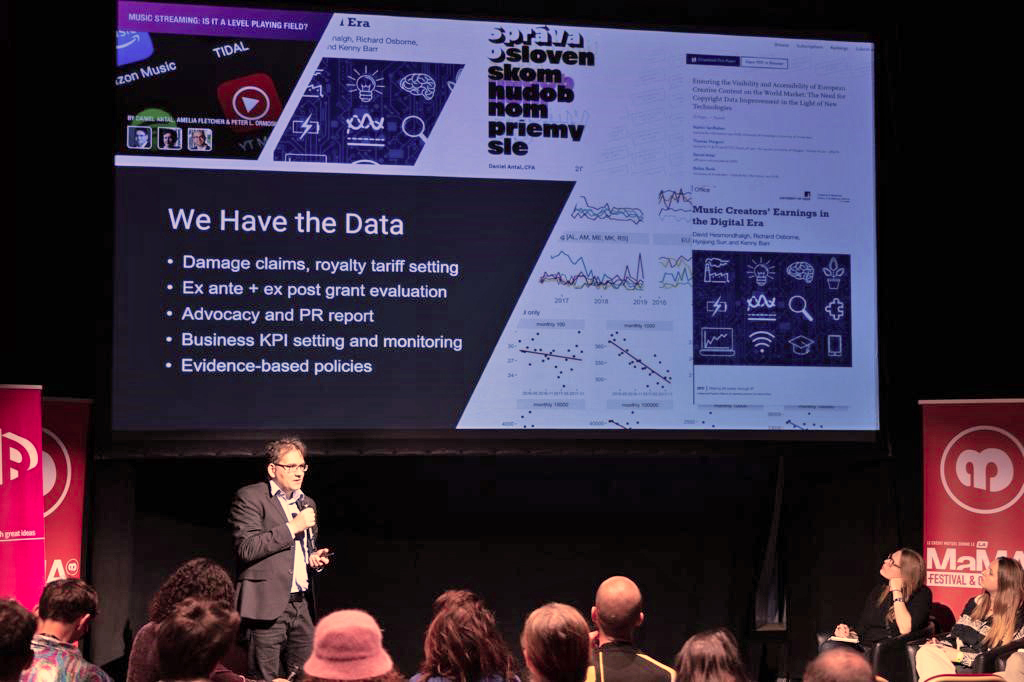
What Do We Offer To Industry Partners?
Our observatory follows the agile open collaboration method from open-source software development, and it has a triangular approach. We believe that data which is created by peer-reviewed, open algorithms, and thus open for review from the business, policy and scientific community is the best addition to your business proprietary data. By sharing data with us, we can build world-class KPIs that give you a competitive edge in the data-driven music industry.
For labels and music publishers: we make big data understandable; we create price and volume indexes of streaming markets; we tell you about price developments and selection probabilities in different cities and countries; we understand the biases of the Spotify and YouTube algorithms; and we measure (meta)data problems and offer scalable solutions.
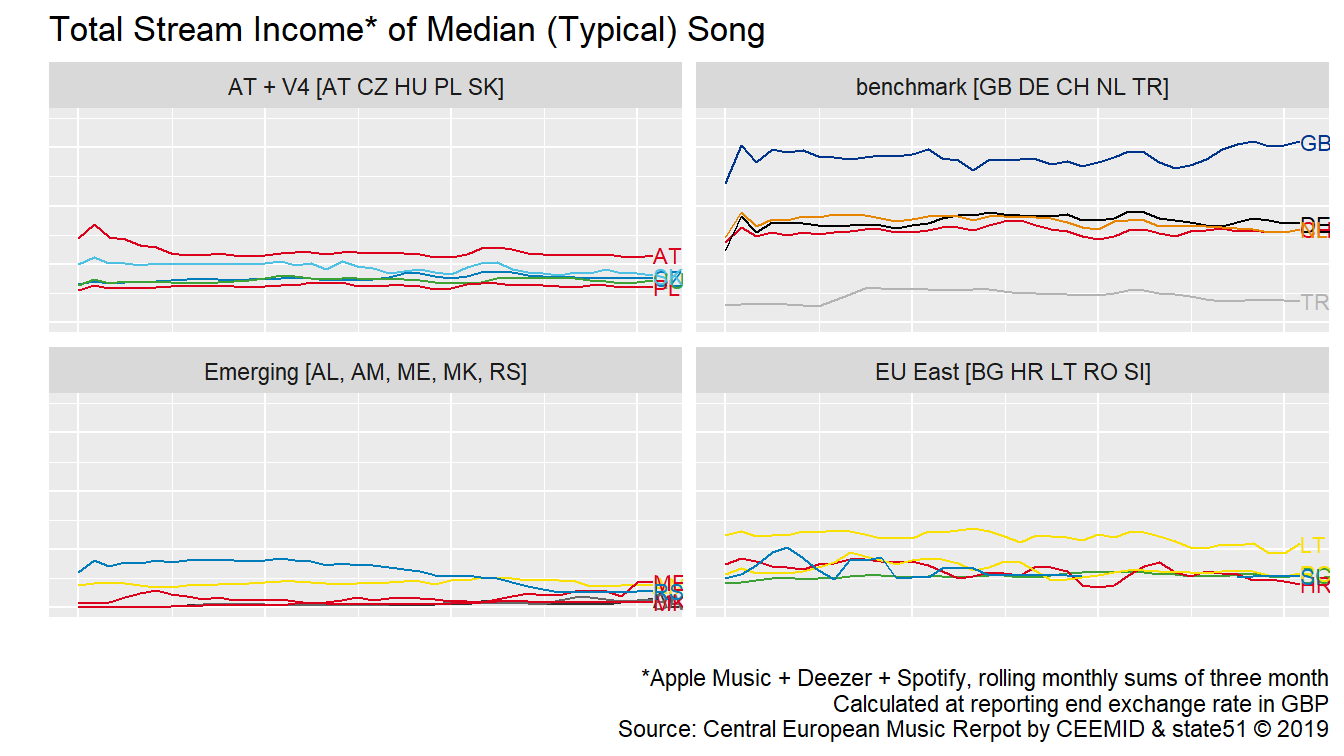
Data Coverage
Our research project contributes to all of the expected outcomes of the call. Our ambition is to develop an open science and open data service which complements the existing statistical service of Eurostat. In partnership with key music industry and policy partners, we are going to fill approximately 41 data gaps within the policy context of Music Moves Europe, as identified by the Feasibility Study for a European Music Observatory, with about 120 high-value indicators. We will develop key performance indicators for music businesses and policy indicators to “better detect the performance of the European music sector and its contribution to economic and social development, as well as to sustainability.”
We believe that existing data availability is better than that described in the Feasibility study. As stated in this final report, the 2019 Open Data Directive further extended the availability of re-usable public sector information (PSI) with open science data. In PSI, open government data, and open science data, there is a huge potential to fill in the data gaps without new data collection—the fact that data can be reused instead of being recollected is the main aim of the directive. These open data sources are legally open but are not accessible without further investment; our Consortium wants to make this investment, and produce about 50% of all the data needs of the future European Music Observatory.
The Digital Music Observatory, which was called CEEMID at the time of the creation of the Feasiblity Study, has 7 years of experience in filling in data gaps with open data. It has created metadata maps to more than 1000 indicators, covering almost all of the data gaps in the Feasiblity Study. We know where to locate data, and now we have to invest in processing, validating, documenting, and making it available for the European music sector.
Pillar 1: Music Economy
In the case of Pillar 1 – Music & Economy, we are usually able to
locate the source of the data, and we have some experience in processing
the data and bringing it to light. We have mapped many perceived data
gaps to the various data harmonization projects of GESAC and CISAC, and
we will seek cooperation with these organizations and their members to
find a secure and voluntary way to retrieve the data.
In other cases, we will rely on on the 2019/1024/EU Open Data Directive to access, process, document, and disseminate the data.
The only data gap that we do not intent do address is the “impact of the non-profit sector”.
Pillar 1 - Music Economy | |||
|---|---|---|---|
Topic | Description | ||
| pillar | problem | availability | feasibility |
| Pillar 1 | Value of music sector | One-off | EY study on the cultural and creative industries (2015) |
| Pillar 1 | Value of music sector | One-off or one recast | CEEMID studies on national music economies |
| Pillar 1 | Employment | One-off | EY study on the cultural and creative industries (2015) |
| Pillar 1 | Employment | One-off or one recast | CEEMID national music industry reports |
| Pillar 1 | Employment | Annual | Eurostat, lacking granularity |
| Pillar 1 | Employment | Data gap | Absence of granularity on the employment of the various sub-sectors, in particular in defining the roles of the various sub-sectors and the importance of the not-for-profit sector in terms of employment. |
| Pillar 1 | Employment | Data gap | HU, SK pilot successful to add granularity. |
| Pillar 1 | Value of music sector | Data gap | No EU-level assessment since 2015 |
| Pillar 1 | Strucutre of the market | Data gap | Absence of pan-European data detailing the number of companies, employees, revenues for the sector and the subsectors. |
| Pillar 1 | The impact of the not-forprofit sector on the overall economy of the music sector | Data gap | No data available on the specific impact of the not-for-profit sector, especially in the live music sub-sector |
| Pillar 1 | Recorded music | Subject to partnership with IFPI | IFPI |
| Pillar 1 | Authors and publisher’s stream | CISAC partnership | CISAC |
| Pillar 1 | Authors and publisher’s stream | GESAC | GESAC |
| Pillar 1 | Recorded music stream - performer rights | Data gap | No aggregated data on neighbouring rights collections Partner with AEPO-ARTIS and SCAP. |
| Pillar 1 | Music publishing | Data gap | No aggregated data on the music European music publishing business |
| Pillar 1 | Synchronisation rights | Data gap | IFPI data available on the recorded music side but not on the publishing side. |
| Pillar 1 | Independent music companies | Data gap | No aggregated data on the independent music sector (value, number of companies, employees, etc.) |
| Pillar 1 | Live music | Data gap | Some data is compiled by Live DMA, ETEP or Yourope, but there is no aggregated data on the pan-European live music sector listing the value of the market, the number and size of venues and shows, number of festivals, share of European artists, among other data points. |
| Pillar 1 | Exports | Data gap | No pan-European data on the export flows between EU countries and outside the EU. |
| Pillar 1 | Exports | Data gap | Embedded cultural tourism export. |
| Pillar 1 | Music retail | Data gap | Granular data on some countries via retail associations (UK, France, Germany) but no pan-European aggregated data. |
| Pillar 1 | Financing of the music sector | Data gap | No aggregated data on how the sector is financed (from investment fund to bank loans and subsidies). |
| Pillar 1 | Live music regulation | Data gap | No aggregated information available on the various legal and tax systems within the EU applied to the live music sector. |
| Pillar 1 | Copyright regulations and evolution of copyright regimes | Data gap | Although many copyright laws applicable in Europe originate from the Commission, there are few instruments available to monitor the state of copyright regulation across the EU |
Pillar 2: Music Circulation & Diversity
We will address the music circulation problems with our WP big data. Together with our leading statistical experts, data scientists, and reproducible research experts we will create sampling techniques that allow to make representative indicators from streaming data. Streaming data is largely accessible, but not in a representative manner. Using advanced statistical methodologies like inverse reverse sampling—which is often used in quantitative finance to analyze large problems—we will create representative data following our pioneering work made in the Central European Music Industry Report and later the Digital Music Creators’ Project initiated by the UK Intellectual Property Office.
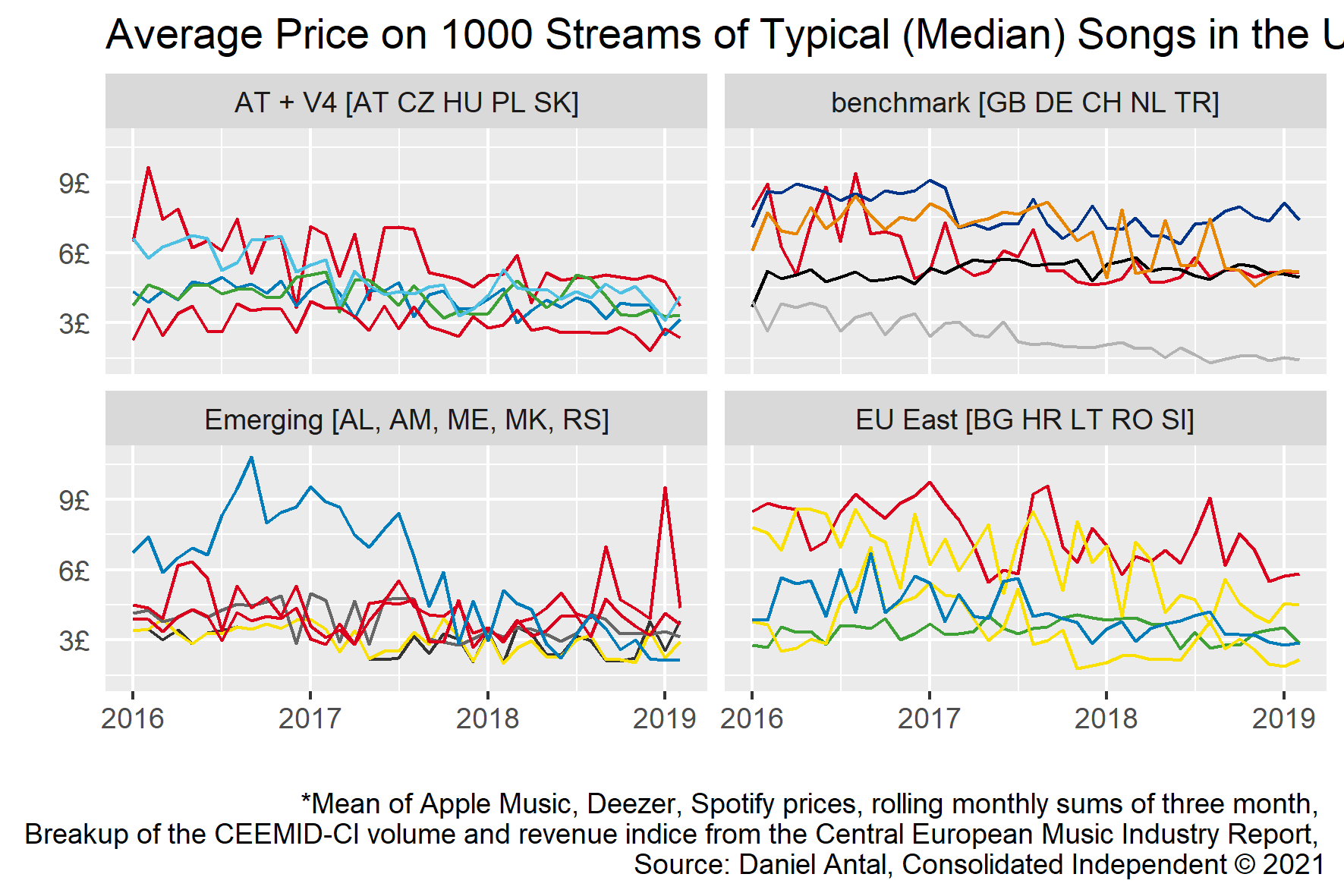
Pillar 2 - Circulation & Diversity | |||
|---|---|---|---|
Topic | Description | ||
| pillar | problem | availability | feasibility |
| Pillar 2 | Streaming activity - volumes | Data gap | Due to the huge volumes of streaming data and the difficulties of accessing this data, monitoring streaming activity could be a challenge. However, the recent announcement by ielsen that they are now providing a global streaming chart, but also national streaming charts, should provide EMO with a potential tool to monitor this activity. |
| Pillar 2 | Live music cross-border activity | Data gap | At this stage there are no pan-European tools that allow for analysis of the cross-border activity of European artists. Listings from Liveurope, ETEP and other exchange programmes will be a good place to start, but these are far from geographically comprehensive and it will be necessary to build a tool to monitor the circulation of European artists. |
| Pillar 2 | Streaming activity - prices | Data gap | Due to the huge volumes of streaming data and the difficulties of accessing this data, monitoring streaming activity could be a challenge. However, the recent announcement by ielsen that they are now providing a global streaming chart, but also national streaming charts, should provide EMO with a potential tool to monitor this activity. |
| Pillar 2 | Streaming activity - exports | Data gap | Due to the huge volumes of streaming data and the difficulties of accessing this data, monitoring streaming activity could be a challenge. However, the recent announcement by ielsen that they are now providing a global streaming chart, but also national streaming charts, should provide EMO with a potential tool to monitor this activity. |
| Pillar 2 | Live music cross-border audiences | Data gap | At this stage there are no pan-European tools that allow for analysis of the cross-border activity of European artists. Listings from Liveurope, ETEP and other exchange programmes will be a good place to start, but these are far from geographically comprehensive and it will be necessary to build a tool to monitor the circulation of European artists. |
| Pillar 2 | Live music cross-border revenues | Data gap | At this stage there are no pan-European tools that allow for analysis of the cross-border activity of European artists. Listings from Liveurope, ETEP and other exchange programmes will be a good place to start, but these are far from geographically comprehensive and it will be necessary to build a tool to monitor the circulation of European artists. |
We will address diversity issues with recycled and harmonized surveys.
Pillar 3: Music & Society
We will mainly rely on the integration of existing, but fragmented and not well-formatted data, and existing, but not processed and not published data to create pan-European indicators for the music and society section.
Pillar 3 - Music & Society | |||
|---|---|---|---|
Topic | Description | ||
| pillar | problem | availability | feasibility |
| Pillar 3 | Music schools and conservatories | Data gap | National statistical institutes, government data |
| Pillar 3 | Music education - formal practices | Data gap | National statistical institutes, government data, European Association for Music in Schools. |
| Pillar 3 | Music education - informal practices | Data gap | The Feasibility Study did not address this, but in popular music, informal learning practices are far-far more important. We will address this issues. |
| Pillar 3 | Training schemes for music professionals | Data gap | Lack of European data on the state of training for music professionals |
| Pillar 3 | Training schemes for artist | Data gap | Lack of European data on the state of training for artists. |
| Pillar 3 | Music education | Data gap | Lack of European data on the state of music education. |
| Pillar 3 | Consumer patterns regarding piracy and its impact on the music sector | Available | Some countries like France with Hadopi have attempted to evaluate the way consumers access illegally music while setting up educational campaigns on piracy, similar to the UK initiative Get It Right. Materials/studies are also provided by EUIPO. |
| Pillar 3 | EU consumers and music | Data gap | No authoritative assessment of the relationship between consumers and music at pan-European level |
| Pillar 3 | Social networks and music | Data gap | No authoritative assessment of how European consumers interact with music on social networks |
| Pillar 3 | Consumer patterns regarding piracy and its impact on the music sector | Available | Limited pan-European data on the impact of piracy but also on the motivations to consumer music content via illegal sources. EUIPO does have some data on the economic cost of IPR infringement in the recorded music industry. |
| Pillar 3 | Scope of the not-for-profit sector in Europe | Data gap | No mapping of the not-for-profit music sector in Europe, in particular in exposing new talent and forging social cohesion. |
| Pillar 3 | Social impact of music in communities | Data gap | Although there is some academic research available, there is no co-ordination of research on the social impact of music in Europe. |
Pillar 4: Music & Innovation
We will connect to several innovation topics in music by providing research, data, and evidence. Building on the work of the Blockchain & Society research project of our Consortium member, the Institute for Information Law IViR at the University of Amsterdam, we will address issues related to NFT and blockchain technologies in music.
Connecting to the work of various music stakeholders in Finland, we will experiment with the safe data sharing of confidential data, avoiding the extreme pitfalls of ‘radical openness’ and ‘closed data’. With the University of Bologna, and eight years of experience in sensitive data sharing with the Digital Music Observatory (formerly: CEEMID), we will create various statistical methods to create anonymized and synthetic datasets that do not endanger business or private data.
We are going to design indicators and carry out a landscape mapping with Music Tech Europe, a new organization that aims to become the representative of music startups and music ecosystems in the European Union.
Pillar 4 - Music & Innovation | |||
|---|---|---|---|
Topic | Description | ||
| pillar | problem | availability | feasibility |
| Pillar 4 | Several reports cover the evolution of music and tec | Available | Music Ally, Midia Research… |
| Pillar 4 | Blockchain and music | Data gap | No authoritative assessment of the impact of Blockchain on the music sector and of the EU-powered initiatives linking Blockchain and music. |
| Pillar 4 | Artificial intelligence, machine learning and music | Data gap | No authoritative assessment of the impact of AI and machine learning on the music sector and of the EUpowered initiatives linking AI and music. |
| Pillar 4 | Future of streaming | Data gap | No authoritative assessment of the future development of streaming and its impact on the EU music sector |
| Pillar 4 | Digital revenues in the music sector and the relevant business models | Data gap | In the UK the report ‘Dissecting the digital dollar’ commission by the MMF to CMU, but no similar European study. |
| Pillar 4 | Mapping the flow of digital revenues in the music sector and the relevant business models in Europe | Data gap | Digital distribution of music has introduced new complex business models that are not always transparent. |
| Pillar 4 | Music start-ups in the EU | Data gap | No authoritative mapping of start-ups involved in music at EU level. |
| Pillar 4 | The impact of artists’ ‘do it yourself’ culture on the economy of the sector | Data gap | Although more artists are going to market with their music without the traditional support of labels, there is no overview of how deep the trend is, how it affects the music ecosystem or what policy frameworks can or should support such activity. |
| Pillar 4 | Funding mechanisms for music | Data gap | No regular overview of the funding schemes in Europe relevant to the music business. |